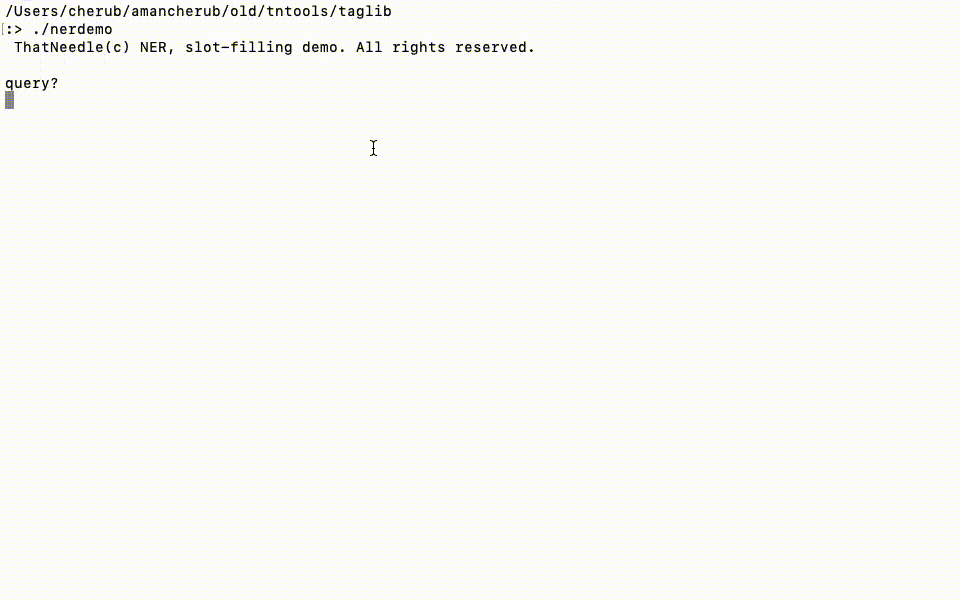Entity Extraction example
Input could be :
blahblah with one hundred sixty six milli litres of paint thinner
The default / "out of the box" output could be a JSON formatted string similar to the one illustrated below (representative only, actual might differ):
{"MEASURE":"166ml", "PRODUCT":"paint thinner",}
i.e the blahblah would be ignored; however it is possible that blahblah could be an important entity for your special niche.
In that case you could custom define blahblah as a special entity named blah_entity. After that, the new special entity would also be recognized and labelled accordingly.
See the screencast below.
About Named Entity Recognition
NER or Named Entity Recognition / Entity extraction identifies, extracts and labels the information in text into pre-defined categories, or classes such as location, names of people, brand, product etc. It is a loosely used term to also include entity-extraction of information such as dates, numbers, phone, url etc.
Entities could be any useful data or information for example, date time, names, location, dimensions etc that could be stored or used for text processing.
Some extractors, identify proper nouns or nouns as entities but thats too rigid and is not a good rigid rule.
A good entity extractor should be able to take a string of unstructured text and identify and produce annotated output or a structured output that helps in intelligent and better analysis of the text.
Such intelligent understanding (NLU) of the intent of the user query will help in producing better responses from the system. If it is a search query, it would mean better understanding of the query and more relevant search results because of better intent inference. Entity resolution and fuzzy matching are also an important part of this process of disambiguation.
There is no universal entity extractor and the needs of the business must be taken into account before selecting a software tool to perform such tasks. Many such general purpose tools might be able to parse general entities like date, time, location etc but give poor accuracy for the context of the business in question, and are therefore not fit to be used in specific niches.
A good tool will recognize the context of the niche and give annotations and analysis accordingly.
Importance of fast entity extraction from natural language
Most language processing software cannot parse the query and analyse the query fast enough to be used effectively in user interfacing applications.
As a result response from the backend query processing system appears to be slow and tests the patience of the end user.
A fast response to the query is essential not only to delight the customer, but to keep him engaged. A slow application will give the user a good reason to direct his valuable attention elsewhere. ThatNeedle has always recognised the need for speed in NLP and is making the core engine faster everyday.
We are also proud to say that we are 10x faster than some leading natural language entity extraction from text service providers
This would make ThatNeedle an ideal candidate for real time extraction tasks from plain text. ThatNeedle NER can serve as an ideal text processing tool for big data scientists, data architects, semantic search solution providers, realtime natural language processing, large scale NLP etc
Out of the box, ThatNeedle could be used as an effective and faster NLP microservice alternative to Microsoft Luis, alternative to IBM watson, alternative to Wit.ai, alternative to api.ai, alternative to Natty etc
Even if you are using traditional specialized parsers like Natty for Java or any similar library for date extraction etc, you should compare the performance with ThatNeedle and decide which is superior for yourself! Thatneedle can provide great speed and accuracy because of its high precision high recall engineering.
How to select named entity extraction tools / software / framework
There are many entity extraction tools / named entity extraction software for NLP floating around in the market. Some are just repackaging open source software, some are repackaging white labelleled software.
There are many open source NER tools, one prominent tool is Stanford NER (in Java). NLTK (Natural Language Tool Kit) is a very popular python library for natural language processing in python. Some tools would require a learning curve and getting familiar with parts of speech tagging and some language processing know how.
While the learning curve is a crucial factor in a business decision, another important thing is to test and compare the tools. We encourage you to try out some open source and commercial software so that you can truly appreaciate the value that ThatNeedle brings to the table.
See how it performs out of the box for the advertised test cases. You should then vary the test cases.
Make a note of the speed and the accuracy of the of software performance. A good NLP topic extraction tool should also have some features to customize for your niche. There is a fair chance you do not have a good dataset to train a fresh ML system for your niche.
Relevant data sets are hard to obtain and one that is sufficiently large in size is rare. While many open source data sets are available, many wont be relevant to you.
Integration is also an issue that should be looked into before selecting anything.
ThatNeedle was designed to make integration with any technology easy. You could be using python, java, c++, ruby, lisp, erlang, golang, scala, node.js etc and you would still be able to use ThatNeedle entity extractor.
What's more the technology is cross platform and would work on your favourite OS. You are requested to please confirm once before purchasing.
See also our new custom
voice commands library offering and
Biomedical research insights .

